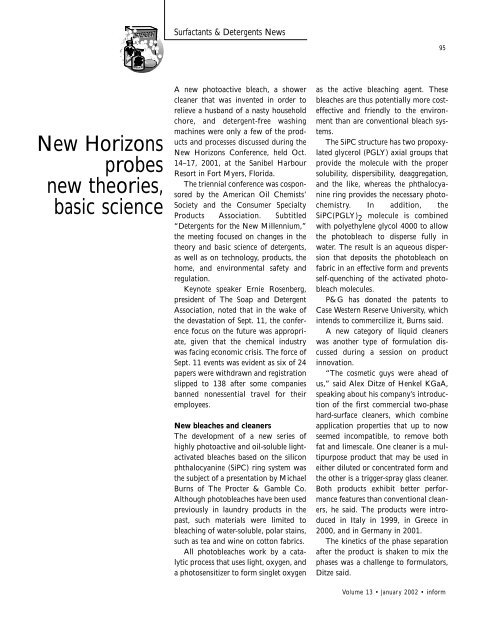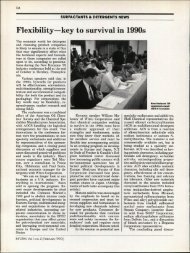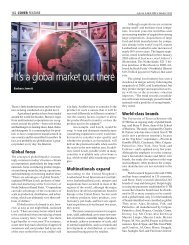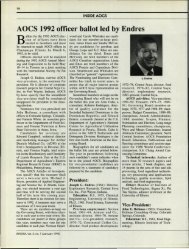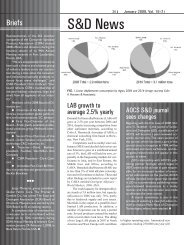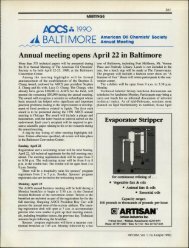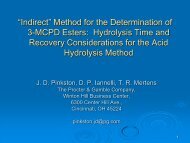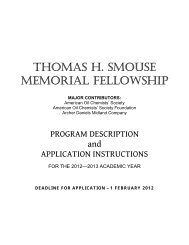10.S & D NEWS - staging.files.cms.plus.com
10.S & D NEWS - staging.files.cms.plus.com
10.S & D NEWS - staging.files.cms.plus.com
You also want an ePaper? Increase the reach of your titles
YUMPU automatically turns print PDFs into web optimized ePapers that Google loves.
New Horizons<br />
probes<br />
new theories,<br />
basic science<br />
Surfactants & Detergents News<br />
A new photoactive bleach, a shower<br />
cleaner that was invented in order to<br />
relieve a husband of a nasty household<br />
chore, and detergent-free washing<br />
machines were only a few of the products<br />
and processes discussed during the<br />
New Horizons Conference, held Oct.<br />
14–17, 2001, at the Sanibel Harbour<br />
Resort in Fort Myers, Florida.<br />
The triennial conference was cosponsored<br />
by the American Oil Chemists’<br />
Society and the Consumer Specialty<br />
Products Association. Subtitled<br />
“Detergents for the New Millennium,”<br />
the meeting focused on changes in the<br />
theory and basic science of detergents,<br />
as well as on technology, products, the<br />
home, and environmental safety and<br />
regulation.<br />
Keynote speaker Ernie Rosenberg,<br />
president of The Soap and Detergent<br />
Association, noted that in the wake of<br />
the devastation of Sept. 11, the conference<br />
focus on the future was appropriate,<br />
given that the chemical industry<br />
was facing economic crisis. The force of<br />
Sept. 11 events was evident as six of 24<br />
papers were withdrawn and registration<br />
slipped to 138 after some <strong>com</strong>panies<br />
banned nonessential travel for their<br />
employees.<br />
New bleaches and cleaners<br />
The development of a new series of<br />
highly photoactive and oil-soluble lightactivated<br />
bleaches based on the silicon<br />
phthalocyanine (SiPC) ring system was<br />
the subject of a presentation by Michael<br />
Burns of The Procter & Gamble Co.<br />
Although photobleaches have been used<br />
previously in laundry products in the<br />
past, such materials were limited to<br />
bleaching of water-soluble, polar stains,<br />
such as tea and wine on cotton fabrics.<br />
All photobleaches work by a catalytic<br />
process that uses light, oxygen, and<br />
a photosensitizer to form singlet oxygen<br />
as the active bleaching agent. These<br />
bleaches are thus potentially more costeffective<br />
and friendly to the environment<br />
than are conventional bleach systems.<br />
The SiPC structure has two propoxylated<br />
glycerol (PGLY) axial groups that<br />
provide the molecule with the proper<br />
solubility, dispersibility, deaggregation,<br />
and the like, whereas the phthalocyanine<br />
ring provides the necessary photochemistry.<br />
In addition, the<br />
SiPC(PGLY) 2 molecule is <strong>com</strong>bined<br />
with polyethylene glycol 4000 to allow<br />
the photobleach to disperse fully in<br />
water. The result is an aqueous dispersion<br />
that deposits the photobleach on<br />
fabric in an effective form and prevents<br />
self-quenching of the activated photobleach<br />
molecules.<br />
P&G has donated the patents to<br />
Case Western Reserve University, which<br />
intends to <strong>com</strong>mercilize it, Burns said.<br />
A new category of liquid cleaners<br />
was another type of formulation discussed<br />
during a session on product<br />
innovation.<br />
“The cosmetic guys were ahead of<br />
us,” said Alex Ditze of Henkel KGaA,<br />
speaking about his <strong>com</strong>pany’s introduction<br />
of the first <strong>com</strong>mercial two-phase<br />
hard-surface cleaners, which <strong>com</strong>bine<br />
application properties that up to now<br />
seemed in<strong>com</strong>patible, to remove both<br />
fat and limescale. One cleaner is a multipurpose<br />
product that may be used in<br />
either diluted or concentrated form and<br />
the other is a trigger-spray glass cleaner.<br />
Both products exhibit better performance<br />
features than conventional cleaners,<br />
he said. The products were introduced<br />
in Italy in 1999, in Greece in<br />
2000, and in Germany in 2001.<br />
The kinetics of the phase separation<br />
after the product is shaken to mix the<br />
phases was a challenge to formulators,<br />
Ditze said.<br />
95<br />
Volume 13 • January 2002 • inform
96<br />
“It can’t separate too quickly or the<br />
consumer is constantly having to shake<br />
the bottle, and yet the adjustment of the<br />
equilibrium should not take too much<br />
time either,” he noted, adding that the<br />
dilutable product separates in around<br />
15 minutes and the spray-on product in<br />
about 30 minutes.<br />
The upper phase of the dilutable<br />
product is a microemulsion consisting of<br />
surfactants, lipophilic materials, and fragrance.<br />
Changing the fragrance oil<br />
changes the phase behavior, so the preferences<br />
of Henkel’s marketing team for<br />
ever-new fragrances caused problems for<br />
the formulators, Ditze said. The upper<br />
phase of the spray product is an oil-inwater<br />
emulsion with medium viscosity.<br />
The lower phase of both products is a<br />
micellar solution with a low pH.<br />
Detergent-free washing machine<br />
In a review of trends in laundry appliances,<br />
Jack Linard of Unilever Home<br />
and Personal Care–North America discussed<br />
a new technology that has pitted<br />
equipment manufacturer Sanyo against<br />
the Japan Soap and Detergent<br />
Association (JSDA).<br />
Sanyo’s Denkaisui machine, introduced<br />
in late June 2001, uses only electrolysis<br />
and ultrasonic waves to clean<br />
and is billed by Sanyo as the world’s<br />
first “detergent-free” washing machine.<br />
JSDA suggested the machines could<br />
cause damage to fabrics and did not<br />
have “adequate cleansing capabilities.”<br />
Sanyo responded by saying that the<br />
JSDA used unrealistically filthy shirts<br />
for its testing. In the end, Sanyo agreed<br />
that consumers may wish to use detergent<br />
to wash very dirty fabrics, Linard<br />
said. Sales in the first two months were<br />
reported at 30,000 units by The<br />
Financial Times, which said that was a<br />
much faster pace than initial sales of<br />
Sanyo’s traditional washers.<br />
Volume 13 • January 2002 • inform<br />
Surfactants & Detergents News<br />
U.S. consumers can expect to see a<br />
number of new models and add-ons as<br />
implementation of new federal washing<br />
machine standards force <strong>com</strong>panies to<br />
produce new washers, Linard said. The<br />
standards require a 22% improvement<br />
in energy efficiency by 2003 and a 35%<br />
overall increase in efficiency by 2007.<br />
Nearly 10% of all new washer sales<br />
in 2000 were “high-efficiency” models,<br />
he said, even without the regulation.<br />
Manufacturers will begin announcing<br />
each washer model’s average maximum<br />
water usage level but there is no limit on<br />
maximum levels. It would be possible,<br />
he said, that some current machines<br />
which don’t meet the efficiency standards<br />
could be replaced by cold-wateronly<br />
machines.<br />
Other than new washing technologies<br />
such as bubble action, used by<br />
Sharp and Daewoo, or ozone, which<br />
remains stuck on the drawing board,<br />
many <strong>com</strong>panies are selling add-on dispensers<br />
and sensors.<br />
“Consumers have yet to find a <strong>com</strong>pelling<br />
reason to pay for these features,”<br />
he said.<br />
Inventing his way out of housework<br />
Bob Black created a new product category<br />
with Clean Shower, a shower-rinsing<br />
agent that removes mineral deposits<br />
and mildew without any manual scrubbing.<br />
Several years ago, Black’s wife was<br />
helping him in a business he owned and<br />
she suggested that he reciprocate by<br />
helping her around the house. His first<br />
job: the shower.<br />
“The first time I tried cleaning the<br />
shower, I said ‘I have to invent my way<br />
out of this problem,’” he explained,<br />
provoking much laughter from his audience.<br />
“Notice that I defined the problem<br />
as not cleaning the shower, not as making<br />
it easier or faster.”<br />
Once he defined what the new product<br />
needed to do, he was ready to formulate.<br />
Details are in U.S. Patents<br />
5,910,474; 5,837,664; 5,587,022; and<br />
5,536,452. Black sold the business to<br />
Church & Dwight in November 1999,<br />
but after two years of retirement has<br />
begun work on his next project, Clean<br />
Toilet.<br />
“Don’t read the literature if you are<br />
thinking of inventing a new thing,” he<br />
suggested, adding that scientists working<br />
for the major consumer-products<br />
<strong>com</strong>panies are “really good at incremental<br />
improvements, but that is in<br />
some ways a trap.”<br />
Antimicrobial products<br />
Jianwen Mao of Ciba Specialty<br />
Chemicals Inc. presented a paper on<br />
antimicrobial household products written<br />
by Dietmar Ochs of Ciba, who was<br />
unable to attend the meeting.<br />
There are cultural differences in the<br />
demand for antimicrobial personalcare<br />
and household products, Mao<br />
said. Consumers in Asian and Latin<br />
American countries want antimicrobial<br />
products because of the climate,<br />
whereas consumers in the United States<br />
want them because they think antimicrobials<br />
promote health. On the other<br />
hand, European consumers, particularly<br />
in Scandinavia and in German-speaking<br />
countries, consider antimicrobial claims<br />
as superfluous because they perceive<br />
removal of microorganisms as one of<br />
the functions of cleaning products.<br />
Mao noted that field studies have not<br />
proven that antimicrobial agents in<br />
household products reduce bacterial<br />
cross-contamination and thus decrease<br />
the risk of infection in private homes.<br />
Other papers presented at the conference<br />
included: “Multiscale Modeling of<br />
Consumer Products” Fiona Case,<br />
Colgate-Palmolive Co.; “Recent
Developments in Gemini Surfactants<br />
and Their Synergistic Interaction with<br />
Other Surfactants,” Milton Rosen,<br />
Brooklyn College; “Basic and Practical<br />
Aspects of the Solubility of Surfactant<br />
Systems,” John Scamehorn, University<br />
of Oklahoma; “Biotechnology in<br />
Cleaning Products: Potential and<br />
Challenges,” Raj Lad, Genencor<br />
International Inc.; “Environmentally<br />
Friendly Performance Products for<br />
Washing, Dishwashing, and Personal<br />
Care Products,” Barbara Karoleski,<br />
Bayer Corp.; “Advances in Alkyl<br />
Benzene Sulphonate Surfactants,”<br />
Kevin Kott, The Procter & Gamble Co.;<br />
“Is There a Future for Home Dry<br />
Cleaning Products?,” James Smith,<br />
ReGenesis LLC; “The Connected<br />
Home,” Herman Cárdenas, GE-Smart;<br />
“Procedures to Promote and Assess the<br />
Environmental Safety and Regulatory<br />
Compliance of Down-the-Drain<br />
Consumer Products,” James McCabe,<br />
The Clorox Co.; “Biodegradation of<br />
Surfactants—An SDA Perspective,”<br />
Alvaro DeCarvalho, The Soap and<br />
Detergent Assoc.; “Surfactants in<br />
Environmental Remediation,” Jeffery<br />
Harwell, University of Oklahoma;<br />
“VOC Issues in Soaps and Detergents,”<br />
Robert Hamilton, Access Business<br />
Group; “Chemical Safety and<br />
Management—Public Policy Drivers in<br />
a Global Economy,” Robert Shimp, The<br />
Procter & Gamble Co.<br />
Papers that were withdrawn because<br />
their authors could not attend the meeting<br />
included “Polymer-Surfactant<br />
Interactions,” R. Nagarajan, The<br />
Pennsylvania State University; “New<br />
Cleaning Method,” Louis Oldenhove,<br />
Colgate-Palmolive R&D Inc. (presented<br />
by Fiona Case); “Use of Nanoparticles<br />
in Home Care: Deposition of<br />
Nanosilicas onto Cellulose Studied by<br />
Reflectometry,” Geoffroy Cedric,<br />
Rhodia; “Innovative Technologies for<br />
Compact Laundry Detergent,” Shu<br />
Yamaguchi, Lion Corp.; “Innovation<br />
Technologies for Cleaning Paper<br />
Products, Akihito Shizuno, Lion Corp.;<br />
and “Using Design for the Environment<br />
Approaches to Improve Chemical<br />
Decision Making,” Bill Hanson, U.S.<br />
Environmental Protection Agency.<br />
Oleochemical conference<br />
paper topics announced<br />
Presentation topics have been<br />
announced for the 2002 World<br />
Oleochemical Conference to be held<br />
April 14–17, 2002, in Barcelona,<br />
Spain.<br />
The program is designed to focus on<br />
issues that will affect the oleochemical<br />
business in <strong>com</strong>ing years. It is being<br />
spnsored by the ASEAN Oleochemical<br />
Manufacturers’ Group (AOMG), the<br />
European Oleochemicals and Allied<br />
Products Group (APAG), the Fatty Oil<br />
Products Committee of the Japan Soap<br />
and Detergent Association (JSDA), the<br />
Industrial Oil Products Division of the<br />
AOCS; and the Oleochemical Steering<br />
Committee of the (U.S.) Soap and<br />
Detergent Association (SDA).<br />
The conference will be divided into<br />
six sessions.<br />
In the oleochemicals overview, presentation<br />
topics will include <strong>com</strong>petitive<br />
practices; a world overview of oleochemicals;<br />
a 20-year outlook, and integration<br />
of oleochemicals into consumer<br />
products.<br />
The raw materials session will<br />
include talks on tallow and bovine<br />
spongiform encephalopathy (BSE);<br />
tropical oils, petrochemical feedstocks,<br />
nontropical oils, emerging oils, and<br />
oleochemical regulations affecting pharmaceutical<br />
uses.<br />
The fatty acids session topics will be<br />
reasons why customers change products,<br />
customer preferences, new developments,<br />
and global capacity.<br />
In the glycerine session, topics will<br />
incude analysis of the North American<br />
market, the European market, the<br />
Asia-Pacific market, synthetic glycerine,<br />
biodiesel, and harmonization of a<br />
global glycerine pharmacopoeia monograph.<br />
The processing and technology session<br />
will include presentations on<br />
Sasol’s alcohol production technology;<br />
using immoblized lipases to produce<br />
diaglycerol; nitrogen-derivative<br />
processing; dicarboxylic acid separation,<br />
and new developments in processing,<br />
additives, and catalyst technology.<br />
The concluding session, on fatty<br />
alcohol and methyl esters, will cover<br />
future use of alcohol, ester, and amine<br />
derivatives in personal-care products;<br />
tertiary amine and derivative markets;<br />
methyl ester and methyl ester sulfonates;<br />
alcohol-related products and<br />
derivatives; and a cost-analysis of using<br />
synthetic alcohol <strong>com</strong>pared to natural<br />
alcohol.<br />
General chairperson for the event is<br />
E.T. Sauer of the United States, with C.<br />
De Coomon of Belgium, S.E. Gloyer of<br />
the United States, J.J. Mahaffey of<br />
Germany, S. Matsuo of Japan, J.L.<br />
Newman of the United States, R.<br />
Pearson of the United Kingdom, R.<br />
Steinmann of Germany, and W. Sutanto<br />
of Singapore serving on the organizing<br />
<strong>com</strong>mittee.<br />
Information about the conference<br />
is available from AOCS, P.O. Box<br />
3489, Champaign, IL 61821-3489,<br />
United States (fax: 1-217-351-8091;<br />
e-mail: meetings@aocs.org; netlink:<br />
www.aocs.org/meetings/oleochem/<br />
index.htm).<br />
97<br />
Volume 13 • January 2002 • inform
98<br />
Technical registrants will receive<br />
tickets for a wel<strong>com</strong>e reception to be<br />
held April 14 and a conference dinner<br />
to held April 16. Guests of technical<br />
registrants may attend the reception<br />
free-of-charge; nontechnical registrants<br />
who wish to attend the dinner must buy<br />
a ticket in advance.<br />
Several tours are planned for ac<strong>com</strong>panying<br />
persons not attending technical<br />
sessions. Tickets may be ordered individually<br />
for each tour, as explained in<br />
registration brochures available from<br />
AOCS.<br />
Briefs<br />
British Petroleum has <strong>com</strong>pleted a<br />
capacity increase at its Lavera, France,<br />
ethylene oxide (EO) facility, expanding<br />
production from 175,000 to 215,000<br />
metric tons per year. BP produces EO<br />
for the manufacture of glycol ethers,<br />
ethanolamines, and brake fluids, as well<br />
Membership in<br />
the Division is<br />
open to any<br />
individual—<br />
it is not<br />
necessary to be<br />
a member of the<br />
AOCS to participate<br />
in Division<br />
activities.<br />
Volume 13 • January 2002 • inform<br />
Surfactants & Detergents News<br />
as using it as a feedstock for polyols and<br />
ethoxylates.<br />
Degussa has sold its 50,000 metric-tonper-year<br />
zeolite production facilities in<br />
Zubillaga-Lantarón, Spain, to FMC<br />
Foret S.A. of Barcelona, Spain. Degussa<br />
shut down production plants in Taipeh,<br />
Taiwan, and Wesseling, Germany,<br />
because it was unable to find a buyer<br />
for them.<br />
P&G Chemicals has increased its glycerine<br />
refining capacity by 10,000 metric<br />
tons as a result of improvements to its<br />
plants in West Thurrock, England, and<br />
Cincinnati, Ohio. The <strong>com</strong>pany plans<br />
to build another refinery capable of<br />
producing 50,000 metric tons of glycerine<br />
annually, according to Donald<br />
Appleby, manager of P&G Chemicals’<br />
glycerine products division. The most<br />
likely plant site is in Kuantan, Malaysia,<br />
although sites in Europe and North<br />
AOCS Surfactants and Detergents Division<br />
America are also under consideration,<br />
he said.<br />
Henkel has entered the detergents market<br />
in the United Kingdom with its Glist<br />
3-in-1 automatic dishwashing tablets.<br />
KeyMaster Technologies Inc. of<br />
Kennewick, Washington, has appointed<br />
Hilary Himpler as vice president of<br />
marketing and business development.<br />
KeyMaster specializes in brand protection,<br />
quality assurance, loss prevention,<br />
and security.<br />
Cognis Thai Ltd. intends to double the<br />
annual surfactant production capacity at<br />
its Bangpakong plant to 60,000 metric<br />
tons by mid-2002, according to<br />
Phantuma Huntrakoon, corporate <strong>com</strong>munications<br />
manager. The facility produces<br />
fatty alcohol sulfates, ether sulfates,<br />
and linear alkylbenzene sulfonate for<br />
detergents and personal-care products. ❏<br />
The objective of the Surfactants and Detergents Division is to promote professional interest, <strong>com</strong>munication,<br />
and <strong>com</strong>petence of individuals interested in all aspects of surfactants and detergents. This objective is attained<br />
by discussion of the sciences and technologies associated with the development and production of surfactants<br />
and detergents. Topics include soaps, oleochemicals, formulation and manufacturing, marketing, detergency<br />
performance test methods, processing, analysis, packaging, fragrances, and ancillary additives.<br />
Activities of the Division:<br />
● Sponsors symposia at the AOCS Annual Meeting & Expo.<br />
● Appoints representatives to all of the program <strong>com</strong>mittees within the AOCS, including publications,<br />
education, membership, and some technical <strong>com</strong>mittees.<br />
● Sponsors a luncheon/business meeting at the AOCS Annual Meeting & Expo for all Division members.<br />
● Involved in the publication of the Journal of Surfactants and Detergents (JSD).<br />
● Publishes a newsletter several times each year.<br />
To join, contact: AOCS, Membership Programs, P.O. Box 3489, Champaign, IL 61826-3489 USA.<br />
Phone: 1-217-359-2344; Fax: 1-217-351-8091; E-mail: membership@aocs.org.


